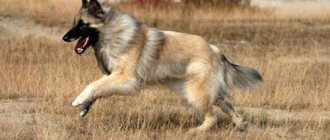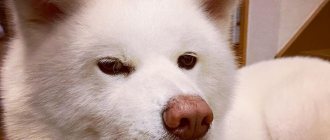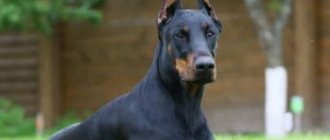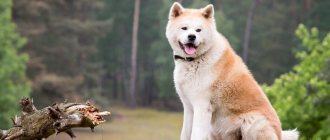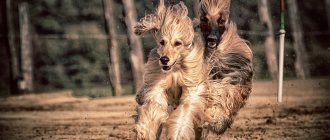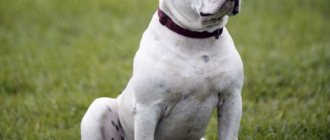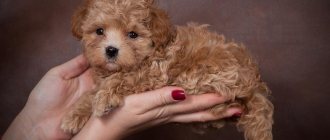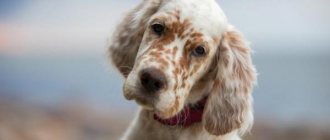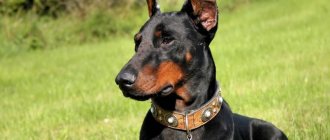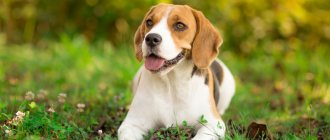Despite such an exotic name for the breed of this dog, it is the oldest in the world and dates back thousands of years. Proof of this is provided not only by rock paintings, but also by numerous studies by genetic scientists.
Japan is considered the birthplace of dogs. Even if you look at a photo of an Akita Inu dog, it will somehow resemble a smiling samurai who faithfully serves his master.
Features of appearance and characteristics of the breed
Looking at the dog, you can immediately understand that eastern blood flows in its veins. They are calm and do not try to break off the leash.
In a circle of strangers, they seem to be the personification of aristocracy, but they show extreme caution and attentiveness.
The Akita Inu dog breed has the following characteristics:
- Adults gain weight from 30 to 45 kg.
- Girls are up to 50 cm tall at the withers. Boys are much larger and grow to 70 cm and higher.
- The color can be very diverse and vary from orange to black.
- They have thick fur with a soft undercoat.
- Regardless of the breed, the eyes are dark brown and the eyelids are black.
- The body is massive and very muscular.
- The tail is high set and curled up
- Dogs live up to 10 years. It is noteworthy that in the vast majority of cases, the life expectancy of boys is longer than that of girls.
- They are stubborn by nature, which can cause some problems during training.
- Akita Inus are quite intelligent and completely adapt to the habits of their owners.
- They are excellent watchdogs. They don’t lose their composure – they won’t rush headlong into a fight.
Distinctive features
Breed standards:
- The head is positioned in proportion to the body. Wide forehead without wrinkles, with a clearly defined transition from forehead to muzzle. Nose with a large black lobe. It is not desirable, but it is acceptable that white dogs have a lighter and more diffuse color. The muzzle is wide, tapering towards the nose.
- The eyes are small brown, with slightly upturned outer corners, giving the impression of a triangular eye shape. Moderately wide apart. It is believed that the closer to black the shade of the eyes, the better.
- The ears are in the middle, thick, triangular in shape with semicircular tips. Standing, leaning forward. Moderately wide apart.
- bite , powerful lips and close-fitting lips.
- They have a muscular and thick neck without a dewlap, located in proportion to the head.
- The paws are powerful and well developed, thick and round in shape. The movements in the gait are elastic.
- The body is balanced, the physique is strong. The height at the withers relative to the length of the body is 10:11, and the female looks more elongated than the males. Has a straight back, deep chest and a well-shaped belly.
- The coat has guard hairs - hard and straight, as well as a soft, thick undercoat. Guard hairs grow in two layers: the outer one is long, the inner one is shorter. Together with the undercoat, three layers of wool are obtained. The function of the layers is as follows: the undercoat warms the dog, the water-repellent outer hair protects it from getting wet by snow or water. Therefore, Akitas tolerate cold and rain well. The hair on the “pants” and shoulder blades is longer than on other parts of the body. The hair on the tail is the longest.
- They have a thick, high-set tail, curled over the back .
Akita Inu varieties
Now this breed can be divided into two varieties: Japanese and American. The Japanese breed is a classic.
Moreover, it almost all died out during the Second World War. And in order to save her from extinction in its pure form, dog handlers needed a lot of effort.
But the American breed appeared thanks to local breeders and became widespread in the post-war period.
Owner reviews
My story of meeting my Sam began more than a year ago.
Today I’m happy with everything, I couldn’t find a better friend, I’m not afraid to walk along dark alleys with him and I’m not afraid to leave him alone in the apartment. He likes to go for walks a lot, although he doesn’t ask for them. The only thing is shedding. For two weeks the entire apartment was covered in wool. I have to run after him with a vacuum cleaner :) Natasha, Moscow
Akita became my first dog. Male. After cats.. The most loyal, wise, obedient, super-duper DOG in the world! he needs to devote a sufficient amount of time, I have it. After work you should always go for a walk. And the dog is happy and you are ready for bed. IMHO!
Surprisingly, my dog tolerates car trips well, although what am I talking about... some say that he behaves calmly for 2-3 hours on an airplane. Now I always take it with me when I go somewhere on personal business. I think he likes it, you can see from his face that he’s happy. Once she saw herself in the side mirror, she admired herself so much! I advise potential owners not to worry, they are kind dogs and, most importantly, wise - so you will definitely find a common language! Try it.
Japanese variety
The Japanese Akita Inu dog is also called triangular because of the unusual shape of its head. She is also given away by her small eyes and slightly upturned nose.
The Japanese Akita, in turn, is divided into two subspecies: red and brindle.
The red subspecies has a uniform red color with light areas in the lower part of the body. But the tiger is replete with different colors: black, red or even blue.
Can I keep it in an apartment or outside?
This breed is quite suitable for keeping in an apartment, but at the same time it requires long, hour-long walks at least twice a day. Since initially this breed is characterized by such properties as power, endurance, strength, dogs need to maintain their athleticism and sportiness .
But still, the best thing for them would be to keep them in a large enclosure in a country house, or even better without a leash, but with the opportunity to hide in a warm booth. Long walks will still be necessary, since they will not play or run around on their own.
American variety
The main difference from its Japanese relative is stockiness and power. In Russia, this particular variety of Akita Inu is most common. They are more courageous and ready to protect not only the owner’s property, but also himself.
Interesting fact: Japanese and American litters can produce long-haired puppies. This is not the standard of this breed, but simply its feature. On average, every fourth Akita Inu puppy has long hair.
Two words about the legendary Hachiko
The story of the dog Hachiko shook all of Japan back in 1932. In honor of the heartbreaking story, a real monument was erected to the dog at the scene of the events.
A dog named Hachiko met his owner every day from work near the train station. But one day the man did not return from work - the owner of his faithful Akita died at work. Over the next 9 years, Hachiko came to the meeting place with the owner every day at the same time and waited for him.
The story gained such resonance that after the death of the dog, mourning was declared in Japan. Today, the Hachiko monument is a symbol of selfless love and fidelity. This story became known to the whole world after the release of the film “Hachiko: The Most Faithful Friend” in 2009.
Training
Due to their stubbornness, Akita Inu are not easy to train. But this is a prerequisite for normal dog socialization. They must understand the owner and distinguish what is bad and what is good.
They are also aggressive towards dogs of other breeds, especially if they are of the same gender. Even if they are girls.
Neapolitan Mastiff - features of the breed and a detailed description of the dog. Character, properties and characteristics inherent in the breed (145 photos)- Great Dane - price, description of the breed and main characteristics of the Great Dane. 110 photos and video descriptions of breed standards
Doberman: description of the breed and character. Tips for training and feeding habits of dogs (95 photos)
Character
Akita Inu dogs are known for their difficult temperament. They are called stubborn, headstrong and independent. The fact is that Akitas have an innate tendency to lead.
If raised incorrectly, they can become disobedient and even aggressive and try to dominate their owner. To avoid this, it is important to build a clear hierarchy in the relationship with the owner from the first days of the dog’s life. Then the pet will perceive him as a leader, which means he will respect and obey.
Among the character traits of the Akita Inu are:
Difficulty with large pets. Akitas do not get along well with dogs of their own species and gender, as well as with dogs that are larger than them, but they get along well with small animals in the same family.
Friendliness. Dogs are great with people, especially adults. There are exceptions if the dog feels hostility or danger on their part.
Love of physical activity. Long walks and active games are the best entertainment for Akitas, which, moreover, is very good for their health.
Fearlessness. Dogs, especially young ones, do not have a fear of heights, which can cause them to injure themselves.
Loyalty. Like the famous Hachiko, Akita Inu are very loyal to their owner, they love to be near him, without distracting him from everyday activities.
Love for affection. Akitas are distinguished by sensitivity and emotional sensitivity, they need tenderness, attention, they can read the mood of the owner, and are sometimes vulnerable and touchy.
Need for space. Although Akitas are capable of living in apartments, being in close quarters is uncomfortable for them. Dogs prefer open spaces with good visibility.
Disinclination to bark. You can hear an Akita barking in quite rare cases. This is a quiet dog that prefers to communicate through snorts, growls or howls.
Diseases and their treatment
Like any other breed, Akitas also have their own diseases, to which the owner should be attentive and respond in a timely manner.
Hip dysplasia. The dog must be x-rayed at the age of two. If dysplasia is detected, the dog is considered unsuitable for subsequent selection and breeding.
Hypothyroidism. A disease of the thyroid gland, which manifests itself as problems with the skin.
Various eye diseases. Cataracts and entropion of the eyelid are common. The weakness to these diseases is hereditary. Retinal dysplasia also often appears.
Red blood cell abnormalities. The peculiarity of the breed is the high content of red blood cells K+ in the blood. Ignorance of this fact leads to incorrect diagnoses and treatment that is not required.
Gastric volvulus. The most common disease. Dry food must be moistened with food. Also, feeding should be done in small portions followed by active walking of the dog.
Negative reviews from hosts
My dog absolutely does not tolerate riding in a car. Literally a couple of kilometers and she immediately vomits. As a puppy, we took her 550 km from home; everyone remembered this trip for a long time. At first she vomited everything that was in her stomach and calmed down a little. The road is long, the dog needed to eat. Everything I ate came out immediately; I can’t tell you the aroma in the car. It was the same at home. With my now adult dog, I can’t drive a car, even around the city.
In 70% of cases, ours pees anywhere, sometimes she even pees while walking. If guests come to us - surprise, Nomi pees in joy where she stands. Of course, we punish her, but we are afraid that it might be some kind of disease of the genitourinary system. We bought a diaper so that at least at night she wouldn’t pee under herself.
We got our Akita just 2 months ago. I understand that it’s hard to demand anything from a two-month-old puppy. But he doesn’t allow anyone to pass through the apartment and constantly bites everyone’s legs. Curses addressed to the puppy are taken offensively, but he continues to grab his legs as if nothing had happened.
Cost of Akita Inu puppies
It is impossible to answer with certainty how much an Akita Inu dog or their puppy costs.
The cost varies from 40 thousand rubles to 70 thousand. Therefore, there is no need to rush into purchasing. You can visit exhibitions where you can find your pet for a reasonable price.
History of origin
Spitz-shaped Chinese dogs, considered the ancestors of modern Akita, appeared on the territory of the Japanese prefecture of the same name in the second millennium BC. e.
In the 6th century, clubs were formed in Japan aimed at preserving the hunting qualities of these dogs. Stud books with a description of the breed's main characteristics date back to the fifteenth century.
Due to the increasing popularity of dog fighting to increase size, starting in 1868, Akitas were crossed with Mastiffs as well as Tosa Inus, resulting in the loss of many of the characteristic Spitz traits.
At the beginning of the twentieth century, dog fighting was banned, but representatives of large Japanese dogs did not disappear, so the history of the Akita breed continues to the present day.
How to choose the right puppy
It is recommended to entrust the choice of a puppy to a specialist. But this is not always possible. Therefore, when choosing, you should proceed from the following rules:
Take the puppy by the cheeks and lift it slightly. The ears should be proportional to each other. They should also be distinguished by dense and thick cartilage tissue.
Feel the puppy. His body should be built and weighty. Try to feel the bones. A large skeleton is a distinctive feature of Akitas.
Check the puppy's fur in the hip area. In both adults and puppies, the coat on the thighs should be coarser than on other parts of the body.
Playfulness of puppies means no psychological abnormalities in the future with proper upbringing. Healthy puppies are constantly active and eccentric.
You can also contact specialized nurseries that breed this particular breed. There they will tell you about the features of care and maintenance and offer their prices for Akita Inu dog puppies.
Nutrition
Due to the specific origin, the dogs for a long time knew nothing but rice, seafood, seaweed and vegetables. Sometimes eggs and game were allowed. This diet is still relevant today, so this list is the basis of the diet.
Akita Inu in hot weather at a watering hole
It is worth considering that Akita Inu may be allergic to other foods that are standard for other breeds. We are talking about poultry meat, veal, fermented milk products with high fat content, as well as cereals such as corn and oats.
If the owner decides to feed the dog factory-made food, then he should pay attention to the fact that the dry food does not contain soy. At the same time, food should be saturated with protein, at least a quarter of the total component.
It is recommended to feed babies of this breed with cottage cheese, boiled fish and vegetables, at least four times a day. But here it is worth noting that before the dog turns two, or better yet, three months, it is not worth separating him from his mom and dad - let him feed on his mother’s milk for a longer time, earning good immunity.
Adults eat two to three times a day. It is also important to provide your four-legged friend with various vitamin and mineral supplements and clean drinking water. Finally, it is worth considering that the serving size should not exceed 10% of the dog’s weight.
Photo of Akita Inu dog
Help the project, repost

1+

